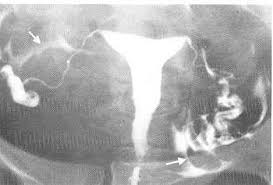 HSG involves the injection of a radio-opaque material into the cervical canal and is followed by fluoroscopy with image intensification.
HSG involves the injection of a radio-opaque material into the cervical canal and is followed by fluoroscopy with image intensification.
There is filling of the uterine cavity and the bilateral filling of the fallopian tube with the injection material.
It has vital role in treatment of infertility especially in case of fallopian tube blockage.
It is used to demonstrate patency of fallopian tubes, access the competency of cervix or congenital abnormality of the uterus in multiple miscarriages, to access patency of fallopian tubes after surgery or tubal ligation or before reversal of tubal ligation.
Rarely, used to access the integrity of caesarean scar.
When oil-based contrast is used rates of pregnancy increase by about 10% compared to water-based contrast studies: due to tubal flushing with the oil-based contrast rather than the imaging procedure itself.
HSG is contraindicated during menstruation, pregnancy, or any unprotected sexual intercourse during the menstrual cycle, any purulent discharge from the vagina, or diagnosis of pelvic inflammatory disease at previous six months.
Those with hypersensitivity to contrast is relatively contraindicated in HSG.
Either high osmolar contrast material (HOCM) or low osmolar contrast material (LOCM) can be used.
The contrast media is prewarmed before being administered into the cervix so as to prevent spasm of fallopian tubes.
The HSG catheter is then inserted into the cervical canal.
The procedure involves fluoroscopy.
Images are taken to demonstrate the filling of endometrial cavity, view of the fallopian tubes demonstrating spillage contrast into peritoneum or the extent of block, and a delayed view if there is abnormal cavities within.
There may be vaginal spotting for one to two days with pain and may persists for up to two weeks.
Some centers give prophylactic antibiotics.
Complications:
infection, allergic reactions to the materials used, intravasation of the contrast material, pain during the procedure, nausea, vomiting, and headache.
Rarely, patients develop neurogenic shock during the inflation of balloon in the cervical canal.
